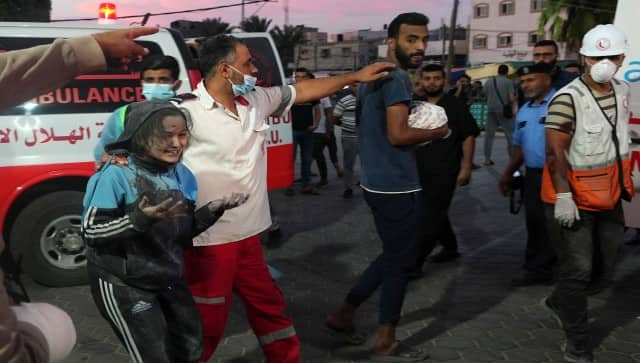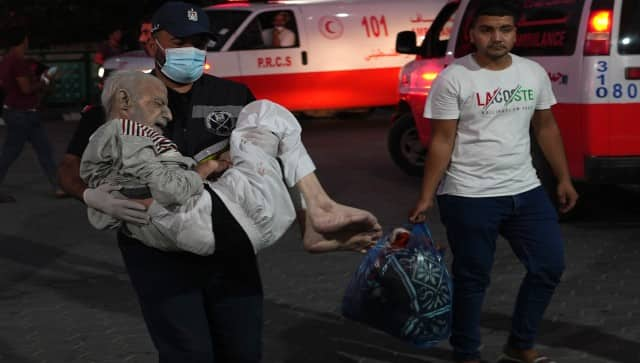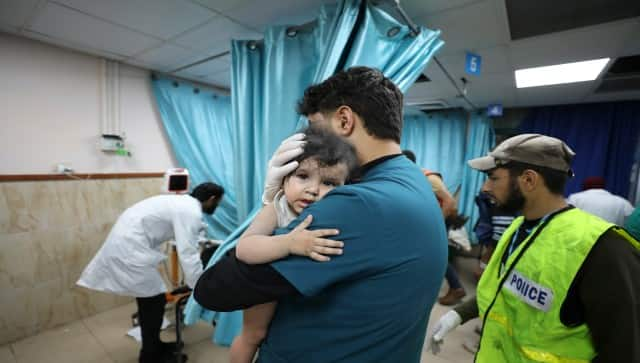Horrifying details from Gaza hospitals are emerging as the Israel-Hamas conflict intensifies. According to a 51-year-old orthopaedic surgeon, the only thing worse than the screams of a patient undergoing surgery without enough anaesthesia are the terror-stricken faces of those awaiting their turn. The hospitals in the region are running out of lighting, clean water, food, and medical supplies as a result of the increased Israeli bombing, forcing doctors to use clothing for bandages, vinegar for antiseptic, and sewing needles for surgical ones. Gaza hospitals nearing collapse Dr Nidal Abed treats patients wherever he can, on the floor, in the corridors, and in rooms crowded with ten instead of two patients, when the Israeli bombing increases and the wounded overflow the Gaza City hospitals where he works. He makes do with anything he can find because he doesn’t have enough medical supplies, using clothes as bandages, vinegar as an antiseptic, and sewing needles as surgical ones. The Israeli siege of the Gaza Strip, which prevents supply of food and other necessities as well as power, is putting hospitals in the region in peril of collapsing. They don’t have clean water. Basic medicines for reducing pain and avoiding infections are becoming scarce. [caption id=“attachment_13284482” align=“alignnone” width=“640”] People are assisted at Shifa Hospital after hundreds of Palestinians were killed in a blast at Al-Ahli hospital in Gaza. Reuters[/caption] Their supply of generator fuel is running low. “We have a shortage of everything, and we are dealing with very complex surgeries,” Abed, who works with Doctors Without Borders, told The Associated Press from Al Quds Hospital. Despite an Israeli military order to evacuate the facility on Friday, the hospital is still caring for hundreds of patients. The hospital compound is now home to about 10,000 Palestinians who were displaced by the explosion. “These people are all terrified, and so am I,” the surgeon said, adding, “But there is no way we’ll evacuate.” Ingenuity is being put to the test in all of the hospitals around the region. Until the stores ran out, Abed reportedly used household vinegar from the corner store as a disinfectant. Now that Israel turned off the water, he cleans wounds by mixing saline with the contaminated water that trickles from faucets. Some staff members were compelled to stitch wounds using sewing needles due to a lack of surgical materials, which Abed claimed can cause tissue damage. Large burns had to be wrapped in clothing due to a lack of bandages, which the doctor indicated could lead to infections. Abed was forced to utilise screws because there weren’t enough orthopaedic implants for his patients’ bones. Since there aren’t enough antibiotics, he administers single pills to patients with severe bacterial illnesses rather than many rounds of antibiotics. “We are doing what we can to stabilise the patients, to control the situation,” he said, adding,“People are dying because of this.” [caption id=“attachment_13284452” align=“alignnone” width=“640”]
 A man brings his baby killed in Israeli bombardment to Al Asa Hospital in Deir el-Balah City, Gaza Strip. AP[/caption] No lights in some hospitals Gaza’s rumbling generators kicked in to keep life-support systems running in hospitals when Israel cut fuel to the territory’s only power plant two weeks ago. To keep them functioning, authorities are scrambling for diesel. The remaining supplies of United Nations organisations are being distributed. Gas tanks are being emptied by motorists. The lights have already been turned out in some hospitals. In Khan Younis, a city in the south, at Nasser Hospital, nurses and surgical assistants held their iPhones over the operating table this week, directing the surgeons with the flashlights as they cut. At Shifa Hospital, Gaza’s biggest, where Abed also worked this week, the intensive care unit runs on generators but most other wards are without power. Air conditioning is a bygone luxury. Abed catches beads of sweat dripping from his patients’ foreheads as he operates. People wounded in the airstrikes are overwhelming the facilities. Hospitals don’t have enough beds for them. “Even a normal hospital with equipment would not be able to deal with what we’re facing,” Abed said. “It would collapse.” Shifa Hospital — with a maximum capacity of 700 people — is treating 5,000 people, general director Mohammed Abu Selmia says. Lines of patients, some in critical condition, snake out of operating rooms. The wounded lie on floors or on gurneys sometimes stained with the blood of previous patients. Doctors operate in crowded corridors filled with moans. The scenes — infants arriving alone to intensive care because no one else in their family survived, patients awake and grimacing in pain during surgeries — have traumatized Abed into numbness. But what still pains him is having to choose which patients to prioritize. “You have to decide,” he said. “Because you know that many will not make it.” “A massacre” After the hospital was struck by a devastating explosion on Tuesday night, Dr Ghassan Abu-Sittah, a plastic surgeon from London, recalled a terrifying incident of the time when he was working in the operating room and the entire ceiling of the operating room fell on them. He told BBC, “I was in the operating room when the missile struck and the full ceiling of the operating cell fell on us. There were amputated parts. There were people with primary amputations. 40 per cent of all the cases that I’ve seen have been children. A lot of them have been like this, they have lost one or two parents. And unfortunately, these kids have a long, long recovery road in front of them.” [caption id=“attachment_13284512” align=“alignnone” width=“640”]
A man brings his baby killed in Israeli bombardment to Al Asa Hospital in Deir el-Balah City, Gaza Strip. AP[/caption] No lights in some hospitals Gaza’s rumbling generators kicked in to keep life-support systems running in hospitals when Israel cut fuel to the territory’s only power plant two weeks ago. To keep them functioning, authorities are scrambling for diesel. The remaining supplies of United Nations organisations are being distributed. Gas tanks are being emptied by motorists. The lights have already been turned out in some hospitals. In Khan Younis, a city in the south, at Nasser Hospital, nurses and surgical assistants held their iPhones over the operating table this week, directing the surgeons with the flashlights as they cut. At Shifa Hospital, Gaza’s biggest, where Abed also worked this week, the intensive care unit runs on generators but most other wards are without power. Air conditioning is a bygone luxury. Abed catches beads of sweat dripping from his patients’ foreheads as he operates. People wounded in the airstrikes are overwhelming the facilities. Hospitals don’t have enough beds for them. “Even a normal hospital with equipment would not be able to deal with what we’re facing,” Abed said. “It would collapse.” Shifa Hospital — with a maximum capacity of 700 people — is treating 5,000 people, general director Mohammed Abu Selmia says. Lines of patients, some in critical condition, snake out of operating rooms. The wounded lie on floors or on gurneys sometimes stained with the blood of previous patients. Doctors operate in crowded corridors filled with moans. The scenes — infants arriving alone to intensive care because no one else in their family survived, patients awake and grimacing in pain during surgeries — have traumatized Abed into numbness. But what still pains him is having to choose which patients to prioritize. “You have to decide,” he said. “Because you know that many will not make it.” “A massacre” After the hospital was struck by a devastating explosion on Tuesday night, Dr Ghassan Abu-Sittah, a plastic surgeon from London, recalled a terrifying incident of the time when he was working in the operating room and the entire ceiling of the operating room fell on them. He told BBC, “I was in the operating room when the missile struck and the full ceiling of the operating cell fell on us. There were amputated parts. There were people with primary amputations. 40 per cent of all the cases that I’ve seen have been children. A lot of them have been like this, they have lost one or two parents. And unfortunately, these kids have a long, long recovery road in front of them.” [caption id=“attachment_13284512” align=“alignnone” width=“640”] Palestinian wounded in the Israeli bombardment of the Gaza Strip are brought to Al Asa Hospital in Deir el-Balah. AP[/caption] “There’s broken glass everywhere, there are lots of people who are seeking refuge in the hospital,” he said, describing what he witnessed as a “massacre.” No proper funerals There isn’t enough clothing left to cover the deceased at the Al-Aqsa Martyrs hospital in central Gaza. The remains are arranged in a courtyard outside the hospital, prayers are made, and grieving family members fall to the ground sobbing. Doctors are battling to save the life of a seriously injured patient while patching up the walking wounded inside the hospital, but resources are running low. According to BBC, doctors reportedly rushed to finish surgeries before moving on to the next patient in a hospital swamped by patients. A queue of vehicles arrived on Sunday morning transporting injured patients to the hospital. “We’ve been here since the crack of dawn and the bodies have completely filled the hospital yard, on top of the bodies which are in refrigerators which are full, inside the hospital building and outside,” a member of staff told the British news channel, adding, “We don’t have enough shrouds for the bodies because the numbers are huge. All bodies are arriving in parts, unattached and in pieces. We can’t identify them because the bodies have been disfigured and crushed.” Despite what we have seen previously, this is a scene we have never seen, he said, calling the situation “unbearable.” [caption id=“attachment_13284522” align=“alignnone” width=“640”]
Palestinian wounded in the Israeli bombardment of the Gaza Strip are brought to Al Asa Hospital in Deir el-Balah. AP[/caption] “There’s broken glass everywhere, there are lots of people who are seeking refuge in the hospital,” he said, describing what he witnessed as a “massacre.” No proper funerals There isn’t enough clothing left to cover the deceased at the Al-Aqsa Martyrs hospital in central Gaza. The remains are arranged in a courtyard outside the hospital, prayers are made, and grieving family members fall to the ground sobbing. Doctors are battling to save the life of a seriously injured patient while patching up the walking wounded inside the hospital, but resources are running low. According to BBC, doctors reportedly rushed to finish surgeries before moving on to the next patient in a hospital swamped by patients. A queue of vehicles arrived on Sunday morning transporting injured patients to the hospital. “We’ve been here since the crack of dawn and the bodies have completely filled the hospital yard, on top of the bodies which are in refrigerators which are full, inside the hospital building and outside,” a member of staff told the British news channel, adding, “We don’t have enough shrouds for the bodies because the numbers are huge. All bodies are arriving in parts, unattached and in pieces. We can’t identify them because the bodies have been disfigured and crushed.” Despite what we have seen previously, this is a scene we have never seen, he said, calling the situation “unbearable.” [caption id=“attachment_13284522” align=“alignnone” width=“640”] Palestinian medic holds a child wounded in Israeli air strike on the Gaza Strip, in Deir el-Balah. AP[/caption] Israeli offensive in Gaza Israel began its bombing campaign after Hamas militants surged across the border on 7 October and killed over 1,400 people, mostly civilians, and abducted more than 200 others. Israel’s offensive has devastated neighbourhoods, shuttered five hospitals, killed thousands and wounded more people than its remaining health facilities can handle. Israeli airstrikes overnight claimed the lives of more than 100 people, according to officials with the Hamas-controlled health ministry. The Israeli military responded by informing the BBC that it had targeted the surrounding regions “based on intelligence information confirming the presence of a Hamas leader in the area adjacent to the hospital, who gave orders to fire towards Israel from that area.” The first food, water and medicine trickled into Gaza from Egypt on Saturday after being stalled on the border for days. Four trucks in the 20-truck aid convoy were carrying drugs and medical supplies, the World Health Organization said. Aid workers and doctors warned it was not nearly enough to address Gaza’s spiraling humanitarian crisis. “It’s a nightmare. If more aid doesn’t come in, I fear we’ll get to the point where going to a hospital will do more harm than good,” Mehdat Abbas, an official in the Hamas-run Health Ministry, said. With inputs from The Associated Press
Palestinian medic holds a child wounded in Israeli air strike on the Gaza Strip, in Deir el-Balah. AP[/caption] Israeli offensive in Gaza Israel began its bombing campaign after Hamas militants surged across the border on 7 October and killed over 1,400 people, mostly civilians, and abducted more than 200 others. Israel’s offensive has devastated neighbourhoods, shuttered five hospitals, killed thousands and wounded more people than its remaining health facilities can handle. Israeli airstrikes overnight claimed the lives of more than 100 people, according to officials with the Hamas-controlled health ministry. The Israeli military responded by informing the BBC that it had targeted the surrounding regions “based on intelligence information confirming the presence of a Hamas leader in the area adjacent to the hospital, who gave orders to fire towards Israel from that area.” The first food, water and medicine trickled into Gaza from Egypt on Saturday after being stalled on the border for days. Four trucks in the 20-truck aid convoy were carrying drugs and medical supplies, the World Health Organization said. Aid workers and doctors warned it was not nearly enough to address Gaza’s spiraling humanitarian crisis. “It’s a nightmare. If more aid doesn’t come in, I fear we’ll get to the point where going to a hospital will do more harm than good,” Mehdat Abbas, an official in the Hamas-run Health Ministry, said. With inputs from The Associated Press
Gaza hospitals are running out of light, clean water, and medical supplies, forcing doctors to use clothing for bandages, vinegar for antiseptic, and sewing needles for surgical ones. Instead of holding proper funerals, the bodies are placed in the courtyard and prayers are recited
Advertisement
End of Article


)

)
)
)
)
)
)
)
)



